 | –≠–ª–µ–∫—Ç—Ä–æ–Ω–Ω—ã–π –∫–æ–º–ø–æ–Ω–µ–Ω—Ç: SP6690EK1 | –°–∫–∞—á–∞—Ç—å:  PDF PDF  ZIP ZIP |
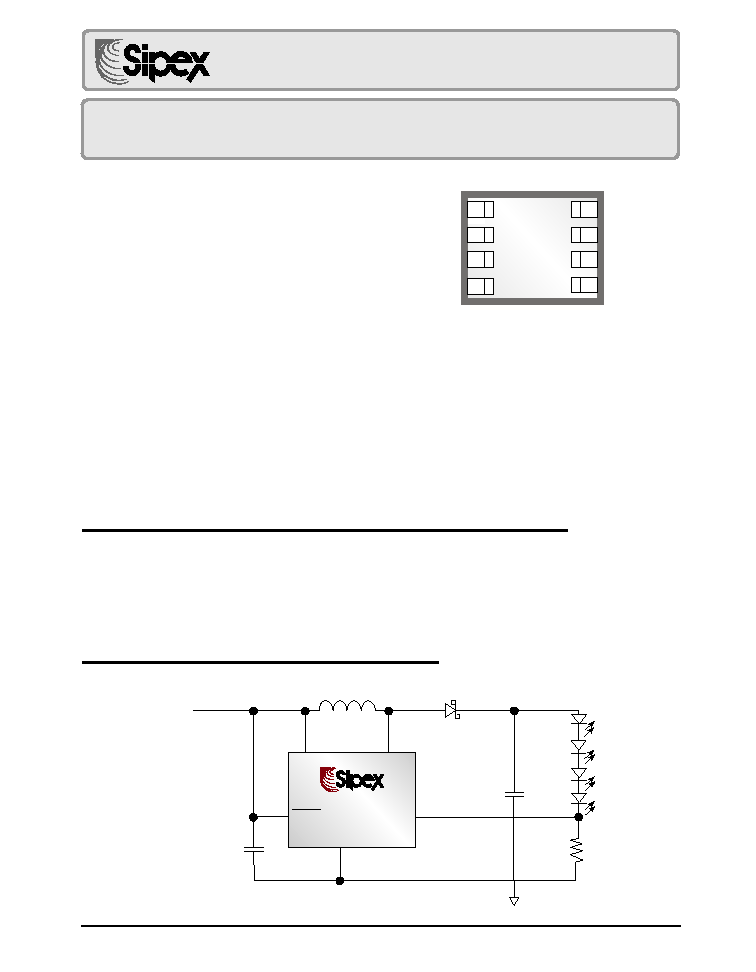
1
Date: 05/25/04
SP6690 Micro Power Boost Regualtor, Series White LED Driver © Copyright 2004 Sipex Corporation
SP6690
FEATURES
Miniature Package: 8 Pin DFN, 5 Pin TSOT
or 5 Pin SOT-23
High Output Voltage: Up to 30V
Optimized for Single Supply,
2.7V - 4.2V Applications
Operated Down to 1V
High Efficiency: Greater Than 75%
Low Quiescent Current: 20µA
Ultra Low Shutdown Current: 10nA
Single Battery Cell Operation
Programmable Output Voltage
1 switch (250mV at 250mA)
Micro Power Boost Regulator
Series White LED Driver
APPLICATIONS
White LED Driver
High Voltage Bias
Digital Cameras
Cell Phone
Battery Backup
Handheld Computers
DESCRIPTION
The SP6690 is a micro power boost regulator that is specifically designed for powering series
configuration white LED. The part utilizes fixed off time architecture and consumes only 10nA
quiescent current in shutdown. Low voltage operation, down to 1V, fully utilizes maximal battery
life. The SP6690 is offered in a 8 pin DFN, 5 pin TSOT or 5 pin SOT-23 package and enables the
construction of a complete regulator occupying < 0.2 in
2
board space.
Æ
TYPICAL APPLICATION CIRCUIT
V
IN
SW
GND
SHDN
FB
10µH
2.2 µF
4.7µF
2.7V to 4.2V
Æ
R
b
SP6690
D1
L1
C1
C2
SP6690
8 Pin DFN
8
7
6
5
1
2
3
4
NC
FB
NC
SW
NC
SHDN
V
IN
GND
Now Available in Lead Free Packaging
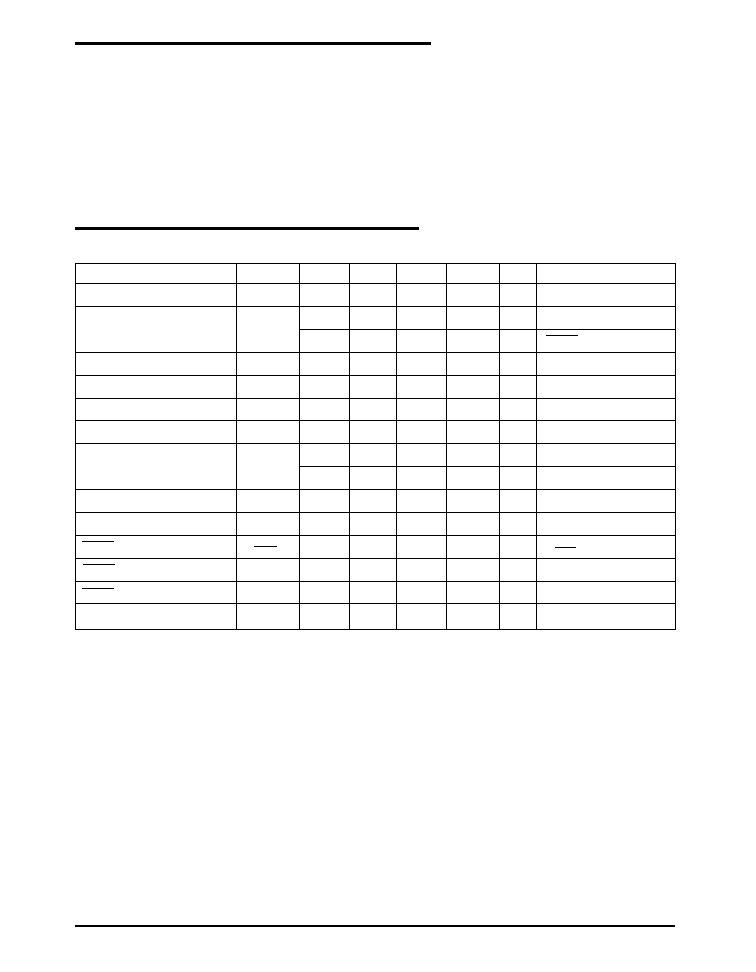
2
Date: 05/25/04
SP6690 Micro Power Boost Regualtor, Series White LED Driver © Copyright 2004 Sipex Corporation
V
IN
....................................................................... 15V
SW Voltage .............................................. -0.4 to 34V
FB Voltage ......................................................... 2.5V
All other pins ................................... -0.3 to V
IN
+ 0.3V
Current into FB ................................................. ±1mA
T
J
Max ............................................................. 125∞C
Operating Temperature Range ............ -40∞C to 85∞C
Peak Output Current < 10us SW .................... 500mA
PARAMETER
SYMBOL
MIN
TYP
MAX
UNITS
CONDITIONS
Input Voltage
V
IN
1.0
13.5
V
Supply Current
I
Q
20
30
µA
No Switching
0.01
1
µA
SHDN = 0V (off)
Reference Voltage
V
FB
1.17
1.22
1.27
V
FB Hysteresis
HYST
8
mV
V
FB
Input Bias Current
I
FB
15
80
nA
V
FB
= 1.22V
Line Regulation
V
o
/V
I
0.1
0.3
%/V
1.2 V
IN
13.5V
Switch Off Time
T
OFF
250
nS
V
FB
> 1V
1200
nS
V
FB
< 0.3V
Switch Saturation Voltage
V
CESAT
170
350
mV
I
SW
= 250mA
Switch Current Limit
I
LIM
250
350
450
mA
SHDN Bias Current
I
SHDN
5
12
µA
V
SHDN
= 3.3V
SHDN High Threshold (on)
V
IH
0.9
V
SHDN Low Threshold (off)
V
IL
0.25
V
Switch Leakage Current
I
SWLK
0.01
5
µA
Switch Off, V
SW
= 5V
Storage Temperature ...................... -65∞C to +150∞C
Power Dissipation. ......................................... 200mW
Lead Temperature (Soldering, 10 sec) ............ 300∞C
ESD Rating ................................................. 2kV HBM
These are stress ratings only and functional operation of the device at
these ratings or any other above those indicated in the operation sections
of the specifications below is not implied. Exposure to absolute maximum
rating conditions for extended periods of time may affect reliability.
ELECTRICAL CHARACTERISTICS
ABSOLUTE MAXIMUM RATINGS
Specifications are at T
A
=25
∞C, V
IN
=3.3, V
SHDN
=V
IN
,
denotes the specifications which apply over the full operating
temperature range, unless otherwise specified.
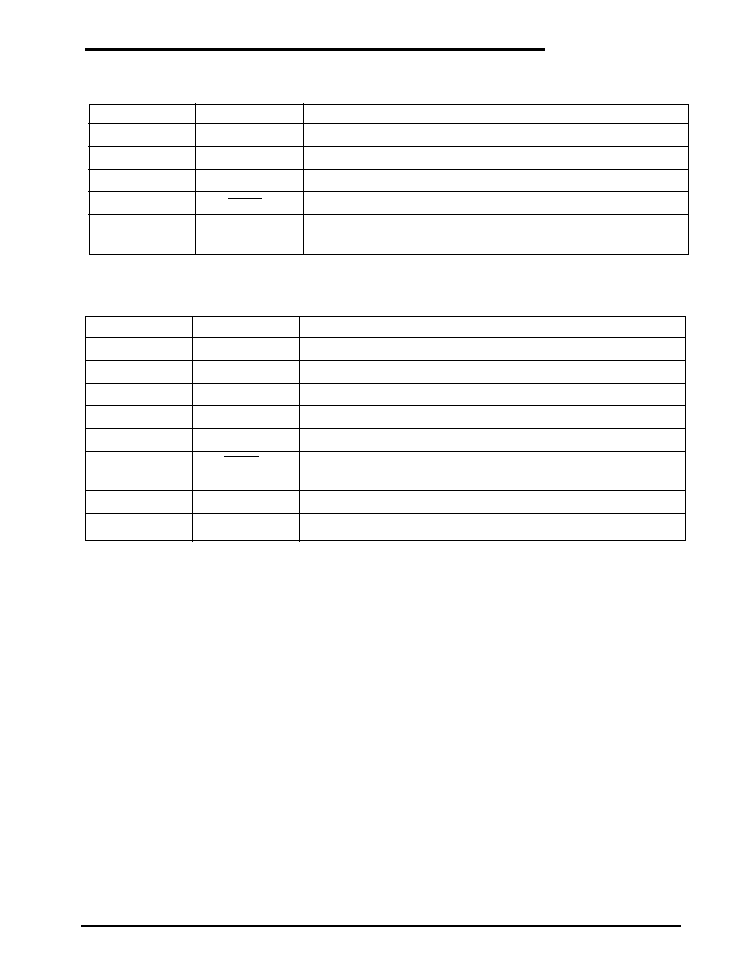
3
Date: 05/25/04
SP6690 Micro Power Boost Regualtor, Series White LED Driver © Copyright 2004 Sipex Corporation
PIN DESCRIPTION
PIN NUMBER
PIN NAME
5 PIN SOT-23 DESCRIPTION
1
SW
Switch input to the internal power switch.
2
GND
Ground
3
FB
Feedback
4
SHDN
Shutdown. Pull high (on) to enable. Pull low (off) for shutdown.
5
V
IN
Input Voltage. Bypass this pin with a capacitor as close to the device
as possible.
PIN NUMBER
PIN NAME
8 PIN DFN DESCRIPTION
1
NC
No connect.
2
FB
Feedback.
3
NC
No connect.
3
SW
Switch input to the internal power switch
5
GND
Ground
6
V
IN
Input Voltage. Bypass this pin with a capacitor as close to the device
as possible.
7
SHDN
Shutdown. Pull high (on) to enable. Pull low (off) for shutdown.
8
NC
No connect.
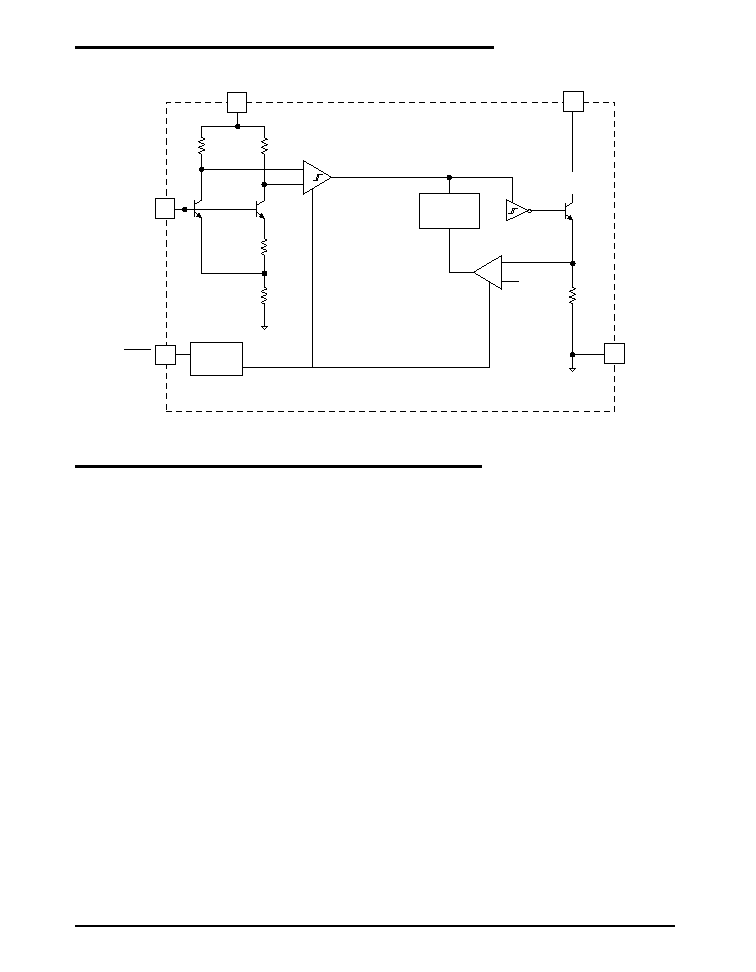
4
Date: 05/25/04
SP6690 Micro Power Boost Regualtor, Series White LED Driver © Copyright 2004 Sipex Corporation
+
-
4
Q1
Q2
R3
R4
R2
R1
X1
Shutdown
Logic
250ns
ONE-SHOT
CLEAR
X2
+
-
SET
DRIVER
52.5mV
0.15
GND
2
1
5
3
SW
POWER
TRANSISTOR
DISABLE
VIN
SHDN
FB
FUNCTIONAL DIAGRAM
THEORY OF OPERATION
General Overview:
Operation can be best understood by referring to
the functional diagram above and the typical
application circuit on the front page. Q1 and Q2
along with R3 and R4 form a band gap refer-
ence. The input to this circuit completes a feed-
back path from the high voltage output through
a voltage divider, and is used as the regulation
control input. When the voltage at the FB pin is
slightly above 1.22V, comparator X1 disables
most of the internal circuitry. Current is then
provided by capacitor C2, which slowly dis-
charges until the voltage at the FB pin drops
below the lower hysteresis point of X1, about
6mV. X1 then enables the internal circuitry,
turns on chip power, and the current in the
inductor begins to ramp up. When the current
through the driver transistor reaches about
350mA, comparator X2 clears the latch, which
turns off the driver transistor for a preset 250nS.
At the instant of shutoff, inductor current is
diverted to the output through diode D1. During
this 250nS time limit, inductor current decreases
while its energy charges C2.
At the end of the 250ns time period, driver
transistor is again allowed to turn on which
ramps the current back up to the 350mA level.
Comparator X2 clears the latch, it's output turns
off the driver transistor, and this allows delivery
of L1's stored kinetic energy to C2. This switch-
ing action continues until the output capacitor
voltage is charged to the point where FB is at
band gap (1.22V). When this condition is
reached, X1 turns off the internal circuitry and
the cycle repeats. The SP6690 contains circuitry
to provide protection during start-up and while
in short-circuit conditions. When FB pin volt-
age is less than approximately 300mV, the switch
off time is increased to about 1.2uS and the
current limit is reduced to about 70% of its
normal value. While in this mode, the average
inductor current is reduced and helps minimize
power dissipation in the SP6690, the external
inductor and diode.
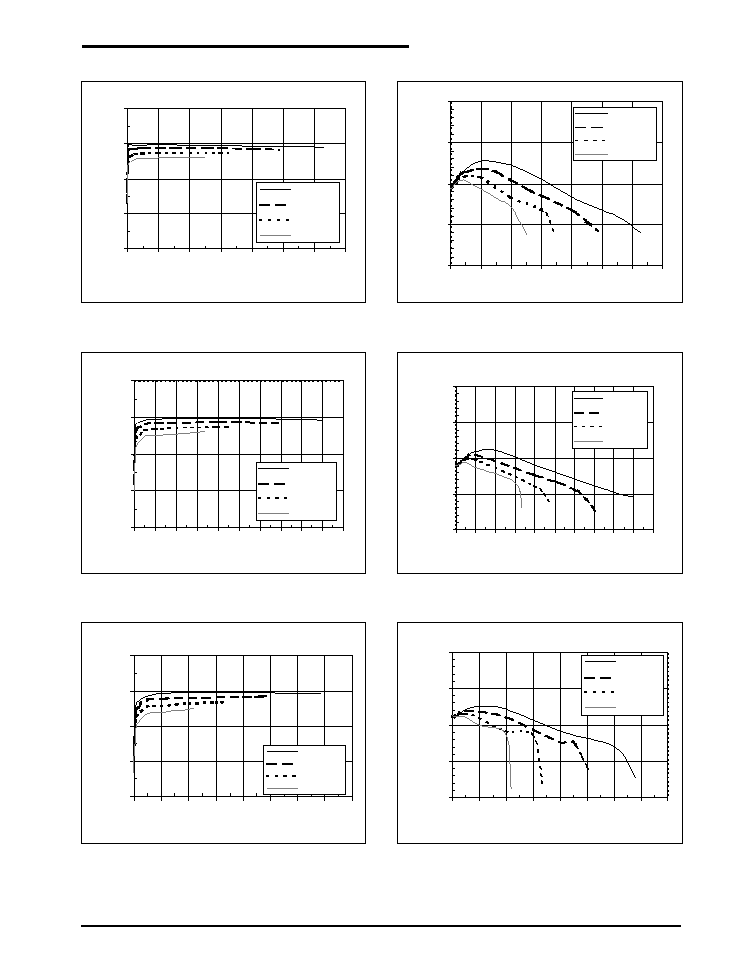
5
Date: 05/25/04
SP6690 Micro Power Boost Regualtor, Series White LED Driver © Copyright 2004 Sipex Corporation
Vout = 12V Efficiency
50
60
70
80
90
0
20
40
60
80
100
120
140
Iout (mA)
Efficiency (%)
Vin = 5.0V
Vin = 4.2V
Vin = 3.3V
Vin = 2.7V
Vout = 12V Load Regulation
11.0
11.5
12.0
12.5
13.0
0
20
40
60
80
100
120
140
Iout (mA)
V
out (V)
Vin = 5.0V
Vin = 4.2V
Vin = 3.3V
Vin = 2.7V
Vout = 15V Efficiency
50
60
70
80
90
0
10
20 30
40
50
60
70 80
90 100
Iout (mA)
Efficiency (%)
Vin = 5.0V
Vin = 4.2V
Vin = 3.3V
Vin = 2.7V
Vout = 15V Load Regulation
14.0
14.5
15.0
15.5
16.0
0
10
20
30
40
50
60
70
80
90 100
Iout (mA)
V
out (V)
Vin = 5.0V
Vin = 4.2V
Vin = 3.3V
Vin = 2.7V
Vout = 18V Efficiency
50
60
70
80
90
0
10
20
30
40
50
60
70
80
Iout (mA)
Efficiency (%)
Vin = 5.0V
Vin = 4.2V
Vin = 3.3V
Vin = 2.7V
Vout = 18V Load Regulation
17.0
17.5
18.0
18.5
19.0
0
10
20
30
40
50
60
70
80
Iout (mA)
V
out (V)
Vin = 5.0V
Vin = 4.2V
Vin = 3.3V
Vin = 2.7V
PERFORMANCE CHARACTERISTICS
Refer to the typical application circuit, T
AMB
= 25
∞C, unless otherwise specified.
Figure 1. 12V Output Efficiency
Figure 2. 12V Output Load Regulation
Figure 3. 15V Output Efficiency
Figure 4. 15V Output Load Regulation
Figure 5. 18V Output Efficiency
Figure 6. 18V Output Load Regulation
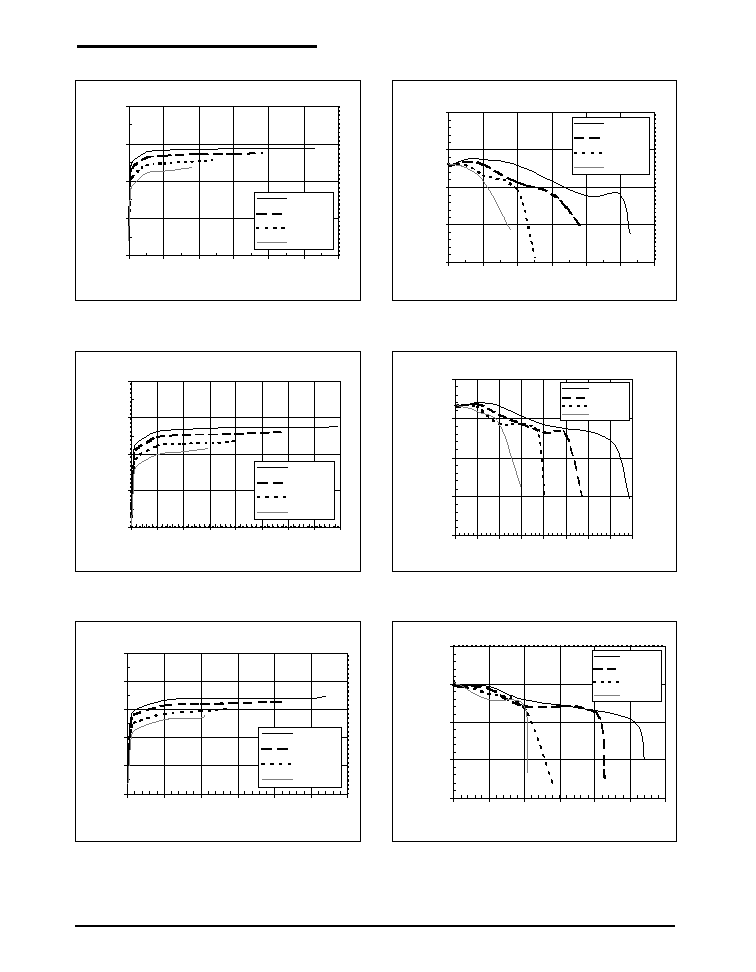
6
Date: 05/25/04
SP6690 Micro Power Boost Regualtor, Series White LED Driver © Copyright 2004 Sipex Corporation
Vout = 21V Efficiency
50
60
70
80
90
0
10
20
30
40
50
60
Iout (mA)
Efficiency (%)
Vin = 5.0V
Vin = 4.2V
Vin = 3.3V
Vin = 2.7V
Vout = 21V Load Regulation
19.5
20.0
20.5
21.0
21.5
0
10
20
30
40
50
60
Iout (mA)
V
out (V)
Vin = 5.0V
Vin = 4.2V
Vin = 3.3V
Vin = 2.7V
Vout = 24V Efficiency
50
60
70
80
90
0
5
10
15
20
25
30
35
40
Iout (mA)
Efficiency (%)
Vin = 5.0V
Vin = 4.2V
Vin = 3.3V
Vin = 2.7V
Vout = 24V Load Regulation
22.5
23.0
23.5
24.0
24.5
0
5
10
15
20
25
30
35
40
Iout (mA)
V
out (V)
Vin = 5.0V
Vin = 4.2V
Vin = 3.3V
Vin = 2.7V
Vout = 30V Efficiency
40
50
60
70
80
90
0
5
10
15
20
25
30
Iout (mA)
Efficiency (%)
Vin = 5.0V
Vin = 4.2V
Vin = 3.3V
Vin = 2.7V
Vout = 30V Load Regulation
28.5
29.0
29.5
30.0
30.5
0
5
10
15
20
25
30
Iout (mA)
V
out (V)
Vin = 5.0V
Vin = 4.2V
Vin = 3.3V
Vin = 2.7V
PERFORMANCE CHARACTERISTICS: Continued
Refer to the typical application circuit, T
AMB
= 25
∞C, unless otherwise specified.
Figure 7. 21V Output Efficiency
Figure 8. 21V Output Load Regulation
Figure 9. 24V Output Efficiency
Figure 10. 24V Output Load Regulation
Figure 11. 30V Output Efficiency
Figure 12. 30V Output Load Regulation
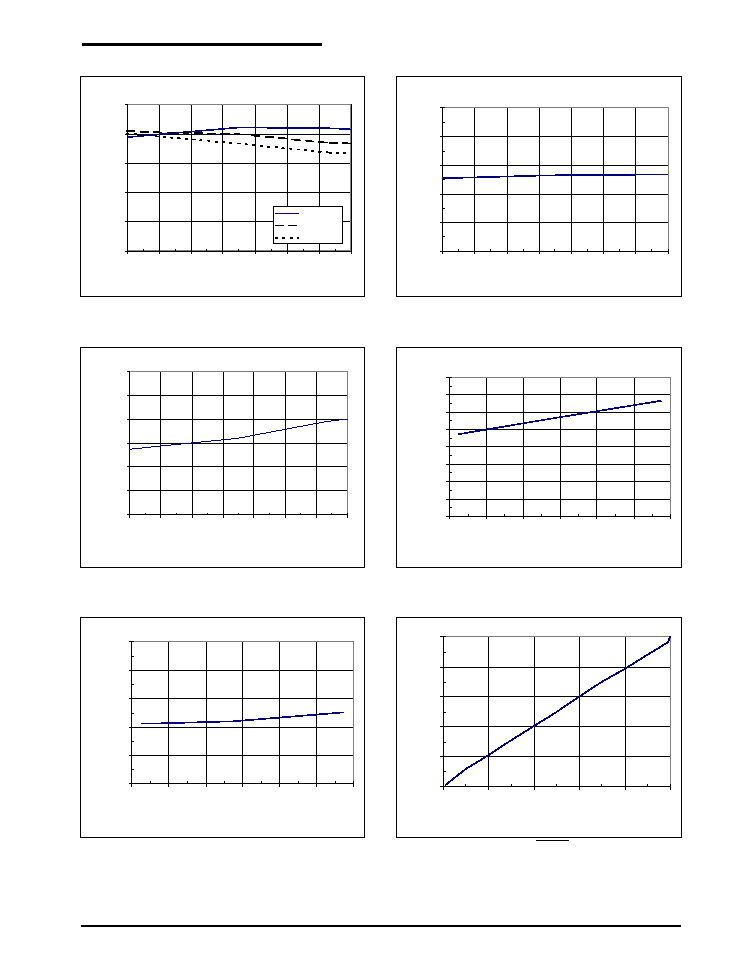
7
Date: 05/25/04
SP6690 Micro Power Boost Regualtor, Series White LED Driver © Copyright 2004 Sipex Corporation
0
5
10
15
20
25
1.2
1.8
2.4
3
3.6
4.2
4.8
5.4
Input Voltage (V)
Quiescent Current (uA)
Tamb=-25C
Tamb=25C
Tamb=85C
0
2
4
6
8
10
1.2
1.8
2.4
3
3.6
4.2
4.8
5.4
Input Voltage (V)
Shutdown Pin Current (µA)
0
100
200
300
400
500
600
1.2
1.8
2.4
3
3.6
4.2
4.8
5.4
Input Voltage (V)
Ipk Current Limit (mA)
0
50
100
150
200
250
300
350
400
-30
-10
10
30
50
70
90
Temperature (∞C)
Switch Saturation V
oltage (mV)
1.20
1.21
1.22
1.23
1.24
1.25
-30
-10
10
30
50
70
90
Temperature (∞C)
Feedback V
oltage (V)
0
4
8
12
16
20
0
20
40
60
80
100
PWM Duty Cycle (%)
A
verage Output Current (mA)
PERFORMANCE CHARACTERISTICS: Continued
Refer to the typical application circuit, T
AMB
= 25
∞C, unless otherwise specified.
Figure 13. Quiescent Current I
Q
vs. V
IN
Figure 14. Shutdown Pin Current vs. V
IN
Figure 15. I
PK
Current Limit vs. V
IN
Figure 16. Switch Saturation Voltage V
CESAT
vs.
Temperature (I
SW
= 350mA)
Figure 17. Feedback Voltage vs. Temperature
Figure 18. Average I
O
vs. SHDN Duty Cycle (V
IN
=3.3V,
Standard 4x20mA WLED Evaluation Board, PWM
Frequency 100Hz)
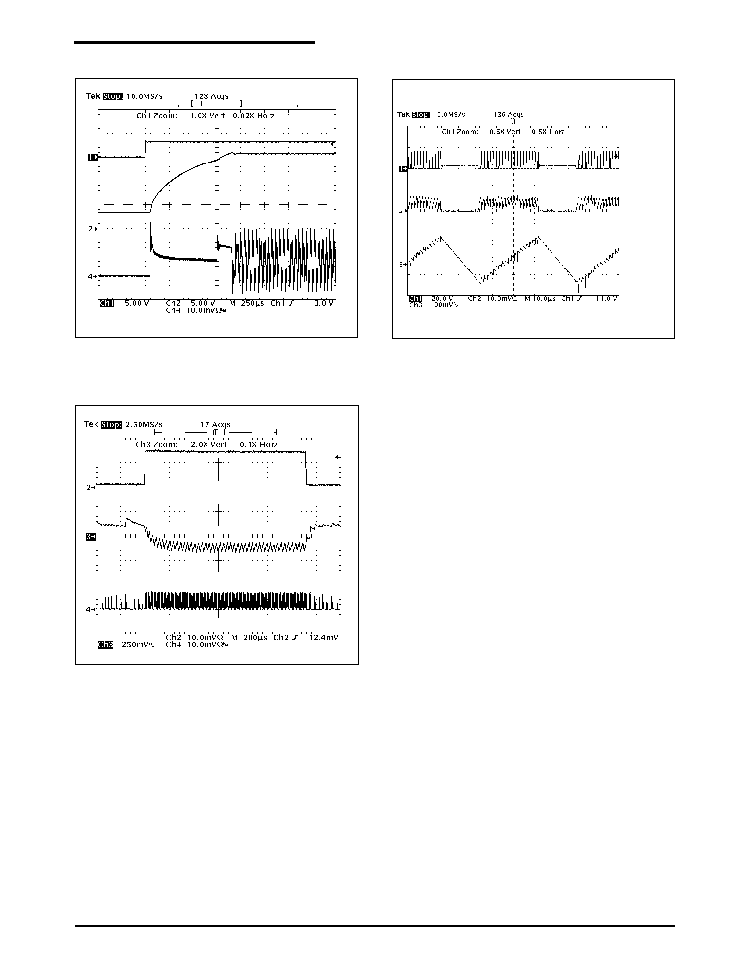
8
Date: 05/25/04
SP6690 Micro Power Boost Regualtor, Series White LED Driver © Copyright 2004 Sipex Corporation
V
SW
I
L
(0.5A/DIV)
V
OUT
(AC)
I
OUT
(10mA/DIV)
V
OUT
(AC)
I
L
(0.5A/DIV)
V
IN
V
OUT
I
IN
(0.2A/DIV)
PERFORMANCE CHARACTERISTICS: Continued
Figure 19. Startup Waveform (V
IN
=3.3V, V
OUT
=15V,
I
OUT
=20mA)
Figure 20. Typical Switching Waveforms (V
IN
=3V,
V
OUT
=15V, I
OUT
=20mA)
Figure 21. Load Step Transient (V
IN
=3V, V
OUT
=21V,
1
15mA Load Step
Refer to the typical application circuit, T
AMB
= 25
∞C, unless otherwise specified.
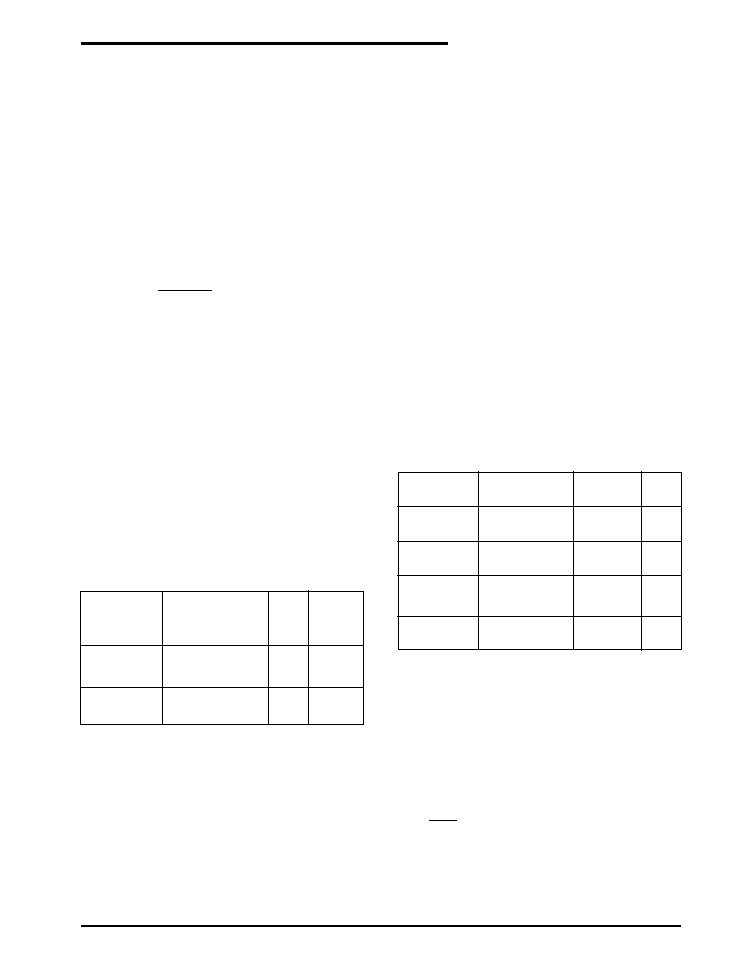
9
Date: 05/25/04
SP6690 Micro Power Boost Regualtor, Series White LED Driver © Copyright 2004 Sipex Corporation
Inductor Selection
For SP6690, the internal switch will be turned
off only after the inductor current reaches the
typical dc current limit (I
LIM
=350mA). How-
ever, there is typically propagation delay of
200nS between the time when the current limit
is reached and when the switch is actually turned
off. During this 200nS delay, the peak inductor
current will increase, exceeding the current limit
by a small amount. The peak inductor current
can be estimated by:
I
PK
=
I
LIM
+
V
IN(MAX)
∑ 200nS
L
The larger the input voltage and the lower the
inductor value, the greater the peak current.
In selecting an inductor, the saturation current
specified for the inductor needs to be greater
than the SP6690 peak current to avoid saturating
the inductor, which would result in a loss in
efficiency and could damage the inductor.
Choosing an inductor with low DCR decreases
power losses and increase efficiency.
Refer to Table 1 for some suggested low ESR
inductors.
Table 1. Suggested Low ESR inductor
MANUF.
PART NUMBER
DCR
Current
(
)
Rating
(mA)
MURATA
LQH32CN100K11
0.3
450
770-436-1300
(10
µH)
TDK
NLC453232T-100K
0.55
500
847-803-6100
(10
µH)
Diode Selection
A schottky diode with a low forward drop and
fast switching speed is ideally used here to
achieve high efficiency. In selecting a Schottky
diode, the current rating of the schottky diode
should be larger than the peak inductor current.
Moreover, the reverse breakdown voltage of the
schottky diode should be larger than the output
voltage.
Capacitor Selection
Ceramic capacitors are recommended for their
inherently low ESR, which will help produce
low peak to peak output ripple, and reduce high
frequency spikes.
For the typical application, 4.7
µF input capaci-
tor and 2.2
µF output capacitor are sufficient.
The input and output ripple could be further
reduced by increasing the value of the input and
output capacitors. Place all the capacitors as
close to the SP6690 as possible for layout. For
use as a voltage source, to reduce the output
ripple, a small feedforward (47pF) across the
top feedback resistor can be used to provide
sufficient overdrive for the error comparator,
thus reduce the output ripple.
Refer to Table 2 for some suggested low ESR
capacitors.
Table 2. Suggested Low ESR Capacitor
MANUF.
PART NUMBER
CAP
SIZE
/VOLTAGE /TYPE
MURATA
GRM32RR71E
2.2
µF
1210
770-436-1300
225KC01B
/25V
/X5R
MURATA
GRM31CR61A
4.7
µF
1206
770-436-1300
475KA01B
/10V
/X5R
TDK
C3225X7R1E
2.2
µF
1210
847-803-6100
225M
/25V
/X7R
TDK
C3216X5R1A
4.7
µF
1206
847-803-6100
475K
/10V
/X5R
LED Current Program
In the white LEDs application, the SP6690 is
generally programmed as a current source. The
bias resistor R
b
, as shown in the typical applica-
tion circuit is used to set the operating current of
the white LED using the equation:
R
b
=
V
FB
I
F
where V
FB
is the feedback pin voltage (1.22V),
I
F
is the operating current of the White LEDs.
In order to achieve accurate LED current, 1%
APPLICATION INFORMAMTION
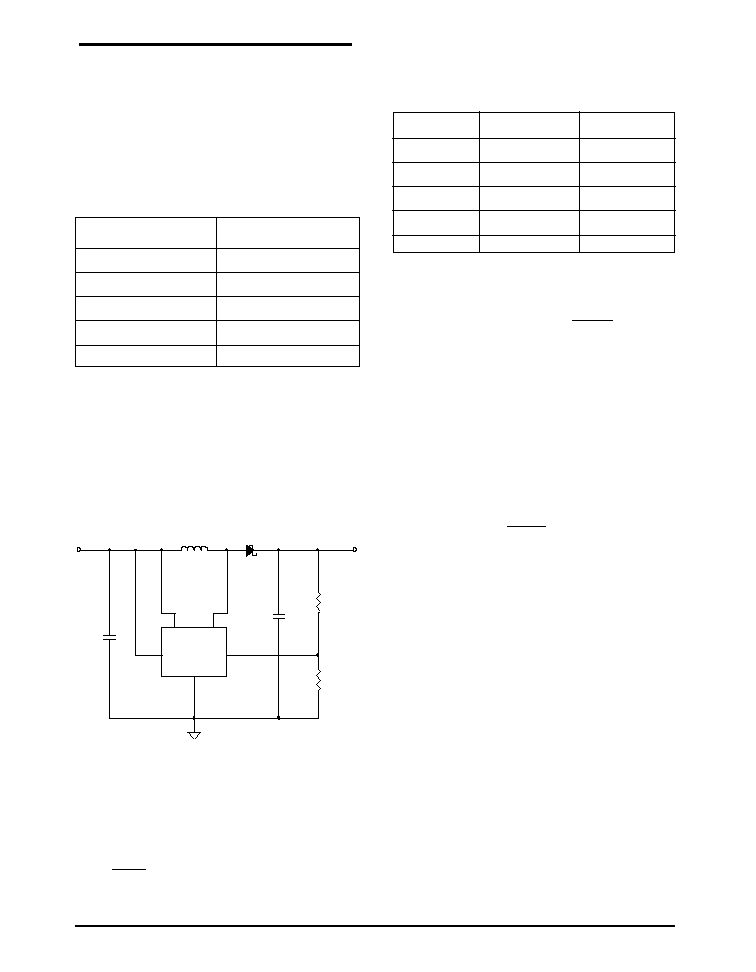
10
Date: 05/25/04
SP6690 Micro Power Boost Regualtor, Series White LED Driver © Copyright 2004 Sipex Corporation
precision resistors are recommended. Table 3
below shows the R
b
selection for different white
LED currents. For example, to set the operating
current to be 20mA, R
b
is selected as 60.4
, as
shown in the schematic.
Table 3. Bias Resistor Selection
I
F
(mA)
R
b
(
)
5
243
10
121
12
102
15
80.6
20
60.4
Output Voltage Program
The SP6690 can be programmed as either a
voltage source or a current source. To program
the SP6690 as voltage source, the SP6690 re-
quires 2 feedback resistors R
1
& R
2
to control
the output voltage. As shown in Figure 22.
Table 4. Divider Resistor Selection
V
OUT
(V)
R
1
(
)
R
2
(
)
12
1M
113K
15
1M
88.7K
18
1M
73.2K
21
1M
61.9K
30
1M
42.2K
Brightness Control
Dimming control can be achieved by applying a
PWM control signal to the SHDN pin. The
brightness of the white LEDs is controlled by
increasing and decreasing the duty cycle of The
PWM signal. A 0% duty cycle corresponds to
zero LED current and a 100% duty cycle corre-
sponds to full load current. While the operating
frequency range of the PWM control is from
60Hz to 700Hz, the recommended maximum
brightness frequency range of the PWM signal
is from 60Hz to 200Hz. A repetition rate of at
least 60Hz is required to prevent flicker. The
magnitude of the PWM signal should be higher
than the minimum SHDN voltage high.
Open Circuit Protection
When any white LED inside the white LED
module fails or the LED module is disconnected
from the circuit, the output and the feedback
control will be open, thus resulting in a high
output voltage, which may cause the SW pin
voltage to exceed it maximum rating. In this
case, a zener diode can be used at the output to
limit the voltage on the SW pin and protect the
part. The zener voltage should be larger than the
maximum forward voltage of the White LED
module.
APPLICATION INFORMAMTION: Continued
L1
1.22V
R2
D1
C1
C2
R1
VOUT
U1
SP6690
1
2
3
4
5
SW
G ND
FB
SHDN
V
I N
VIN
Figure 22. Using SP6690 as Voltage Source
The formula and table for the resistor selection
are shown below:
R
1
=
(
V
OUT
- 1
)
∑ R
2
1.22
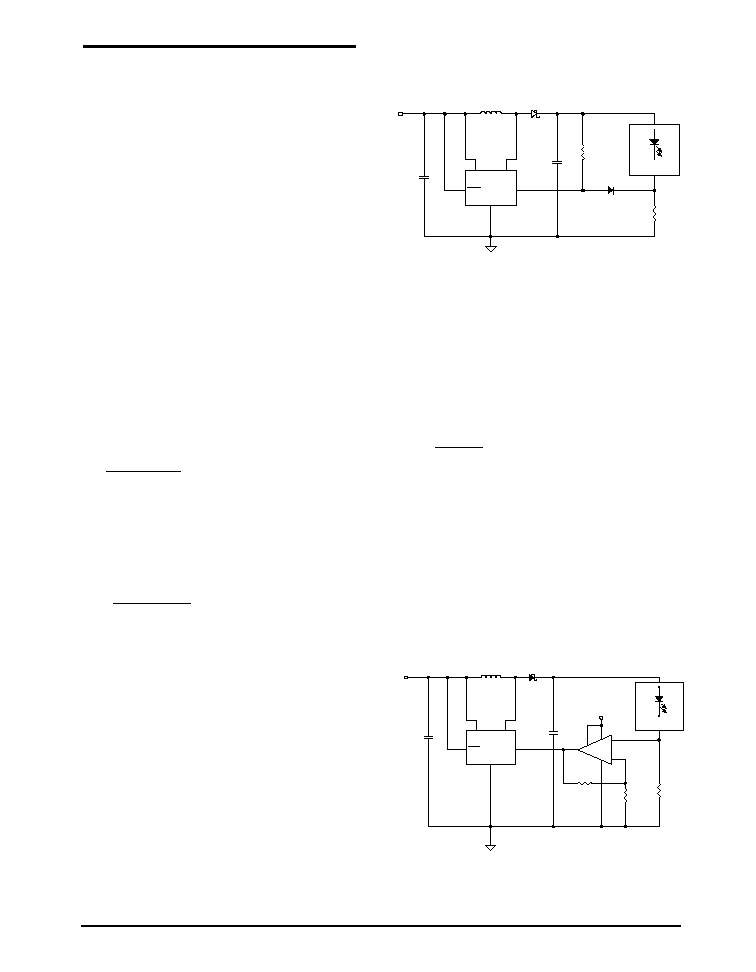
11
Date: 05/25/04
SP6690 Micro Power Boost Regualtor, Series White LED Driver © Copyright 2004 Sipex Corporation
Layout Consideration
Both the input capacitor and the output capacitor
should be placed as close as possible to the IC.
This can reduce the copper trace resistance
which directly effects the input and output
ripples. The feedback resistor network should
be kept close to the FB pin to minimize copper
trace connections that can inject noise into the
system. The ground connection for the feedback
resistor network should connect directly to the
GND pin or to an analog ground plane that is tied
directly to the GND pin. The inductor and the
schottky diode should be placed as close as
possible to the switch pin to minimize the noise
coupling to the other circuits, especially the
feedback network.
Power Efficiency
For the typical application circuit, the output
efficiency of the circuit is expressed by
=
V
OUT
∑ I
OUT
V
IN
∑ I
IN
Where V
IN
, I
IN
, V
OUT
, I
OUT
are the input and
output voltage and current respectively.
While the white LED efficiency is expressed by
=
(V
OUT
- 1.22) ∑ I
OUT
V
IN ∑
I
IN
This equation indicates that the white LED
efficiency will be much smaller than the output
efficiency of the circuit when V
OUT
is not very
large, compared to the feedback voltage (1.22V).
The other power is consumed by the bias resis-
tor. To reduce this power loss, two circuits can
be used, as shown in Figure 23 and Figure 24. In
Figure 23, a general-purpose diode (for ex-
ample, 1N4148) is used to bring the voltage
across the bias resistor to be around 0.7V. R
1
is
used to create a loop that provides around 100
µA
operating current for the diode. 3% efficiency
improvement can be achieved by using this
APPLICATION INFORMAMTION: Continued
method.
Figure 23. Improve Efficiency with Diode in Feedback
Loop
To further improve the efficiency and reduce the
effects of the ambient temperature on the diode
D1 used in method 1, an op amp circuit can be
used as shown in Figure 24. The gain of the op
amp circuit can be calculated by:
Av =
R
1
+ R
2
R
1
If the voltage across the bias resistor is set to be
0.1V the current through R
1
and R
2
to be around
100
µA, R
1
and R
2
can be selected as 1K and
11.2K respectively. LMV341 can be used be-
cause of its small supply current, offset voltage
and minimum supply voltage. By using this
method, the efficiency can be increased around
VIN
WLED MODULE
C1
4.7uF
Murata LQH32CN100K11
DS
MBR0530
D1
DIODE
34.8ohm
Rb
C2
2.2uF
R1
150Kohm
L1 10uH 0.45A
1.22V
2.7-4.2V
0.7V
U1
SP6690
1
2
3
4
5
SW
GND
FB
SHDN
V
IN
LMV341
1
3
4
+
-
OUT
2
6
0.1V
C2
2.2uF
2.7-4.2V
L1 10uH 0.45A
1.22V
Vbattery
U1
SP6690
1
2
3
4
5
S W
GND
FB
SHDN
V
IN
5
DS
MBR0530
R1
1K
WLED MODULE
C1
4.7uF
R2
11.2K
Vbattery
Murata LQH32CN100K11
Rb
5.1
7%.
Figure 24. Improve Efficiency with Op Amp in Feedback
Loop
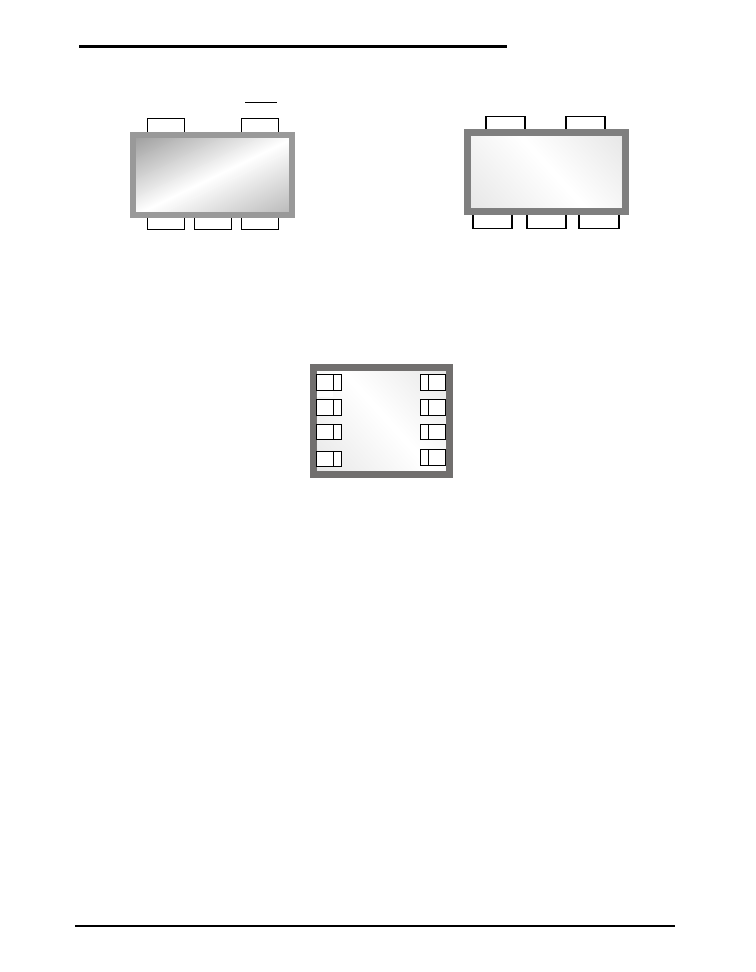
12
Date: 05/25/04
SP6690 Micro Power Boost Regualtor, Series White LED Driver © Copyright 2004 Sipex Corporation
SP6690
5 Pin SOT-23
V
IN
SHDN
SW
GND
FB
5
4
1
2
3
SP6690
8 Pin DFN
8
7
6
5
1
2
3
4
NC
FB
NC
SW
NC
SHDN
V
IN
GND
PACKAGE: PINOUTS
5
4
1
2
3
SP6690
5 Pin TSOT
V
IN
SHDN
SW
GND
FB
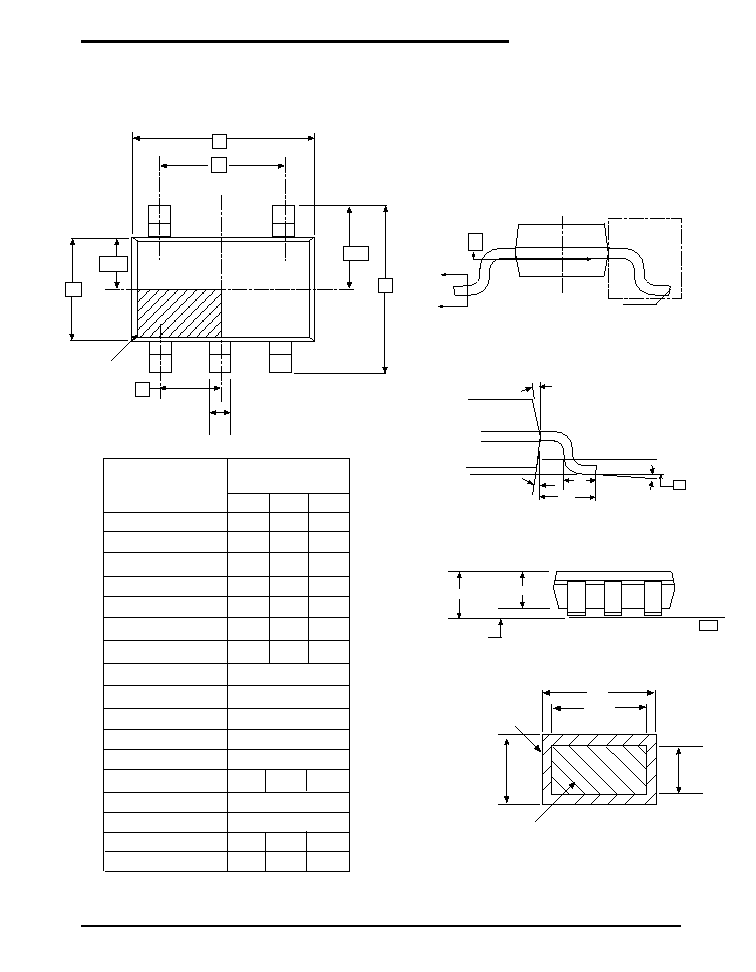
13
Date: 05/25/04
SP6690 Micro Power Boost Regualtor, Series White LED Driver © Copyright 2004 Sipex Corporation
PACKAGE: 5 PIN TSOT
A
A2
A1
SIDE VIEW
L1
L
4X ¯1
ÿ1
Seating Plane
Gauge Plane
VIEW C
SEE VIEW C
H
B
B
SEATING PLANE
C
¯
- - 1.10
0 - 0.10
Dimensions in (mm)
5 PIN TSOT
JEDEC MO-193
(AB) Variation
0.70 0.90 1.00
0.30 - 0.50
0.08 - 0.20
2.90 BSC
2.80 BSC
1.60 BSC
0.30 0.45 0.60
0.60 REF
0∫ 4∫ 8∫
A
A1
A2
b
D
E
E1
L
L1
L2
ÿ
4∫ 10∫ 12∫
ÿ1
MIN NOM MAX
0.25 BSC
b1
0.30 0.40 0.45
c
c1
0.08 0.13 0.16
0.95 BSC
1.90 BSC
e
e1
L2
c
WITH PLATING
BASE METAL
b
c1
b1
D
E
E/2
e1
N/2
2
1
b
e
E1
E1/2
N
N/2
+1
INDEX AREA
(D/2 X E1/2)
Detais of the pin1 identifier are optional,
but must be located within the zone
indicated.
5 PIN TSOT

14
Date: 05/25/04
SP6690 Micro Power Boost Regualtor, Series White LED Driver © Copyright 2004 Sipex Corporation
PACKAGE: 5 PIN SOT-23
A
A2
A1
SIDE VIEW
D
E
E/2
e1
N/2
2
1
b
e
E1
E1/2
N
N/2
+1
L1
L
L2
4X
ÿ1
Seating Plane
Gauge Plane
VIEW C
SEE VIEW C
H
B
B
c
WITH PLATING
BASE METAL
b
ÿ1
ÿ
- - 1.45
0 - 0.15
Dimensions in (mm)
5 PIN SOT-23
JEDEC MO-178
(AA) Variation
0.90 1.15 1.30
0.30 - 0.50
0.08 - 0.22
2.90 BSC
2.80 BSC
1.60 BSC
0.30 0.45 0.60
0.60 REF
0∫ 4∫ 8∫
A
A1
A2
b
c
D
E
E1
L
L1
L2
ÿ
5∫ 10∫ 15∫
ÿ1
MIN NOM MAX
0.25 BSC
e
e1
1.90 BSC
0.95 BSC
5 PIN SOT-23
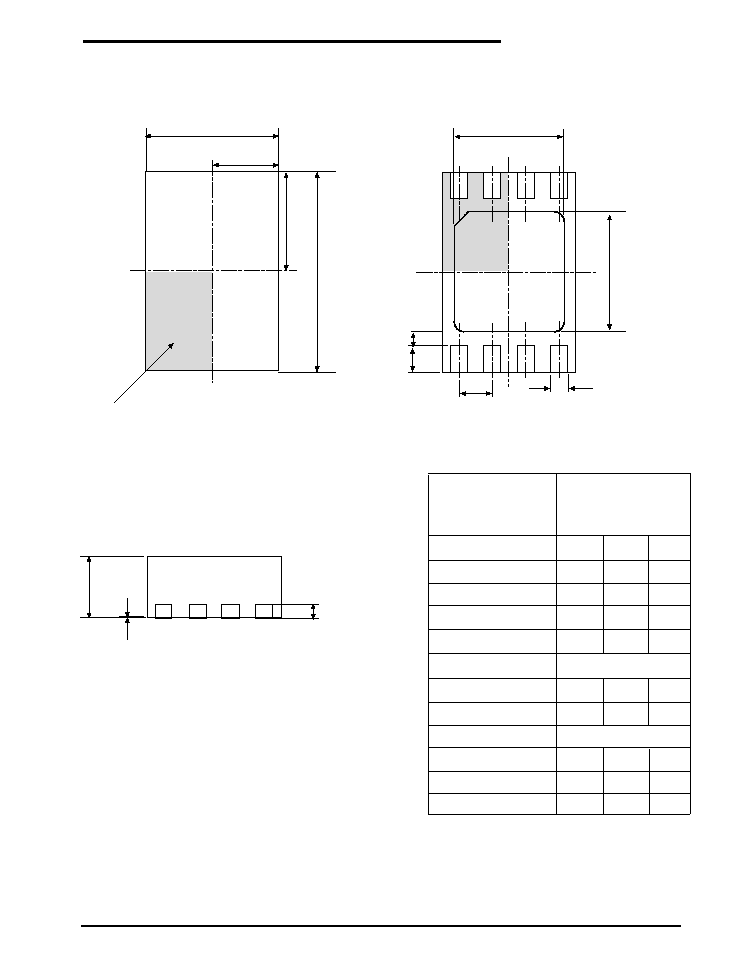
15
Date: 05/25/04
SP6690 Micro Power Boost Regualtor, Series White LED Driver © Copyright 2004 Sipex Corporation
PACKAGE: 8 PIN DFN
Top View
D
A
D2
Bottom View
E2
b
e
L
A1
A3
E
E/2
D/2
1
2
K
K
Side View
Pin 1 identifier to be located within this shaded area.
Terminal #1 Index Area (D/2 * E/2)
2x3 8 Pin DFN
JEDEC mo-229C
(VCED-2) Variation
Dimensions in (mm)
Symbol
MIN
NOM
MAX
A
A1
A3
b
D
D2
E2
e
L
0.80
0.90
1.00
0 0.02 0.05
0.20
2.00 BSC
1.50
1.75
0.30
0.40
0.50
1.60
1.90
0.18
0.25
0.30
0.50
2x3 8 Pin DFN
E
3.00 BSC
-
-
-
-
-
-
0.20
-
-
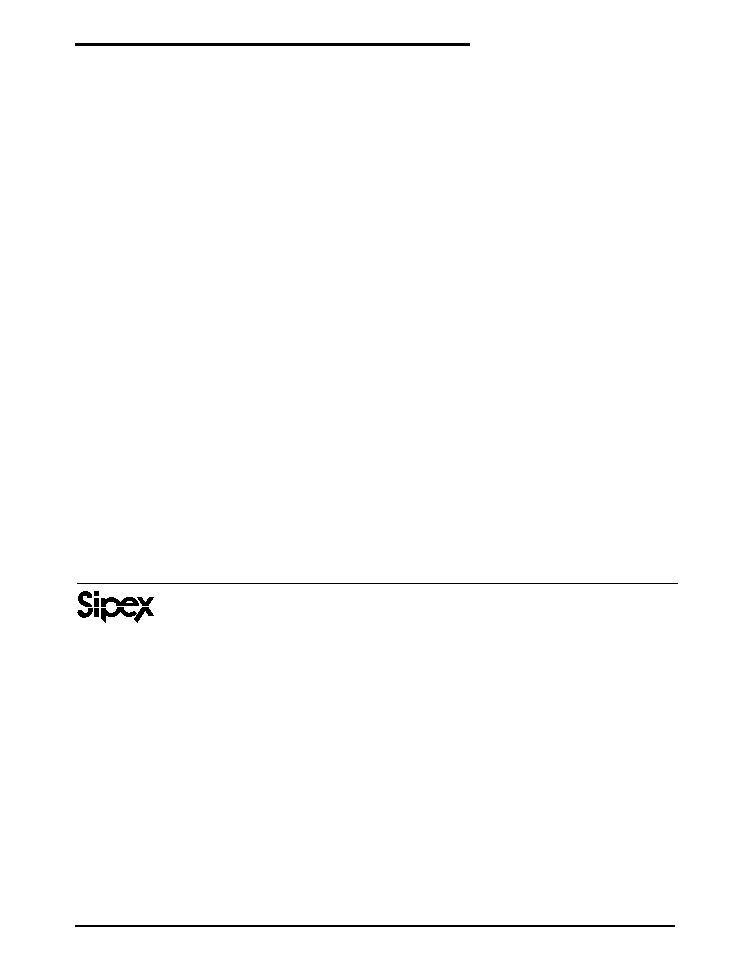
16
Date: 05/25/04
SP6690 Micro Power Boost Regualtor, Series White LED Driver © Copyright 2004 Sipex Corporation
Corporation
ANALOG EXCELLENCE
Sipex Corporation reserves the right to make changes to any products described herein. Sipex does not assume any liability arising out of the
application or use of any product or circuit described herein; neither does it convey any license under its patent rights nor the rights of others.
Sipex Corporation
Headquarters and
Sales Office
233 South Hillview Drive
Milpitas, CA 95035
TEL: (408) 934-7500
FAX: (408) 935-7600
ORDERING INFORMATION
Part Number
Topmark
Temperature Range
Package Type
SP6690EK1 ....................... P3WW ...................... -40∞C to +85∞C ............................. 5 Pin TSOT
SP6690EK1/TR .................. P3WW ...................... -40∞C to +85∞C ............................ 5 Pin TSOT
SP6690EK ......................... C3WW ...................... -40∞C to +85∞C .......................... 5 Pin SOT-23
SP6690EK/TR .................... C3WW ...................... -40∞C to +85∞C ......................... 5 Pin SOT-23
SP6690ER ........................ 6690ES ..................... -40∞C to +85∞C ............................... 8 Pin DFN
SP6690ER/TR .................. 6690ES ..................... -40∞C to +85∞C .............................. 8 Pin DFN
/TR = Tape and Reel
Pack quantity is 2500 for TSOT or SOT-23 and 3,000 for DFN.
Available in lead free packaging. To order add "-L" suffix to part number.
Example: SP6690ER/TR = standard; SP6690ER-L/TR = lead free















